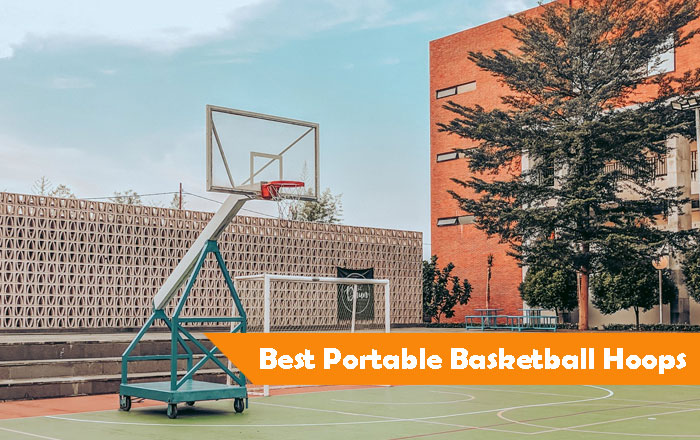
A fast-paced lifestyle comes with its own set of drawbacks, one of which is fewer opportunities to relax. This is especially true if you’re the athletic type who prefers to use sports to unwind—such as basketball.
However, not everyone who enjoys a good game of hoops has the luxury of time to travel to their local gym or park.
Manufacturers have capitalized on this unique problem—enter the mobile basketball hoop. Portable basketball hoops allow you to play the sport we've all grown to love, in your driveway, your friend's driveway, an empty lot—wherever you like. All you need is ample space.
Your next question might be, what's the best portable basketball hoop? If so, you're in luck. Today, we'll be covering everything you need to know about mobile basketball hoops, including the pros and cons of each type, and our top picks. We've diversified this list of the best outdoor portable basketball hoops to suit every kind of player.
- Best Overall portable hoop
- Slam-it Pro rim is built to take a slam
- 54-Inch Makrolon Polycarbonate with Fade-Resistant Graphics
- Toughest portable basketball hoop
- Angled Pole for more playing area
- 54-inch Plexiglass backboard
- Best portable hoops for kids
- For indoor and outdoor use
- Light on the wallet
- Great value for money
- Anti-rust, anti-UV, weather-resistant
- 44-Inch Polyethylene Backboard
- Best for Mobility
- ErgoMove wheel-barrow design for an easy lift-and-roll action
- 54-inch acrylic backboard
Best Portable Basketball Hoops
When it comes to choosing an outdoor basketball hoop, you need to ask yourself a question or two. Does your driveway have adequate space? Is your home frequently subject to gusty winds and wayward debris? Could it endure rugged action and power plays?
The Lifetime 71524 Portable Basketball System is a top contender for the best rollaway basketball hoop on the market. Based on user feedback, its backboard can take hard shots just like a pro court tempered glass board. This aspect makes it a fantastic choice for those who want a quality portable basketball hoop that mimics the gym experience.
The material used for the backboard is another highlight. Its 54-inch polycarbonate backboard employs Makrolon technology. Polycarbonate is a durable plastic material with many uses outside sporting equipment, like eyewear, electronics, and LED lighting.
A gripe that many players have about hoops with a polycarbonate backboard is its tendency to degrade and discolor, especially when directly exposed to harsh elements. That's not the case for the Lifetime 71524. Its fade-resistant design can weather the adverse effects of UV rays, heavy rain, and snowfall.
The steel pole attaches to a heavy-duty, 35-gallon base, which can be filled with water or sand. Assembly is easy, and you can refer to the manual for a hassle-free installation. Like many other options on our list, this hoop has an adjustment range of 7.5 feet to 10 feet.
Pros:
- The backboard is wide and see-through—perfect for free-throw practice.
- Its basket has a high-quality rim and netting.
- You're less susceptible to injuries when dunking or hanging from the hoop.
- Its sleek, clear polycarbonate backboard design looks nice in any driveway.
Cons:
- Users report difficulty in following the manual.
The Spalding Pro Slam portable basketball hoop is designed to withstand slam dunks. Its sturdy base accommodates 34 gallons of sand or water, making it an excellent choice for aggressive players who can't resist the temptation to grab the rim.
This heavy-duty basketball hoop features an adjustable height of 7.5 feet to 10 feet and a breakaway rim with sturdy netting that’s perfect for intense dunking. Even the backboard is made with durability in mind: Plexiglass.
In a pro court, such as the NBA, the go-to-choice is a tempered glass backboard, a type of safety glass that's significantly more robust than standard glass. Its stiff surface is what produces the audible boing whenever you shoot a ball.
Since a tempered glass backboard is too fragile to install on a mobile basketball system, an acrylic backboard (more commonly known as Plexiglass) is preferable. It emulates the gameplay you experience with a tempered glass backboard, and it's also less susceptible to breakage.
The Pro Slam's 54-inch backboard mounts on a solid steel frame attached to a three-piece pole, meaning it's heavy. Due to its weight and size, consider installing the Spalding NBA 54 in your driveway. You can also choose a wider area, like your backyard.
It may take some time for taller players to get used to the angled post, in which case you may opt for its larger backboard size, a 60-inch variant, "The Beast." Either way, this is our top pick for the toughest portable basketball hoop.
Pros:
- You can adjust the height between 7.5 to 10 feet, using patented Exactaheight technology.
- Its sturdy base lessens tipping and wiggling.
- The see-through backboard presents more opportunities to practice free throws.
Cons:
- It requires at least two people to set it up and assembling it may take several hours.
The Giantex Portable Basketball Hoop is a great choice if you’re looking to bond with children over a casual game of hoops. A standout feature of this mobile basketball system is its adjustable height. It offers an impressive range between 6.6 feet to 10 feet.
Both its base and backboard are plastic, making it much lighter and more portable than most basketball goals in this list. The base holds between 66 pounds and 88 pounds of sand or water.
However, since the Giantex uses a standard rim, think twice before dunking on this portable hoop. It’s also a bad idea to hang on its netting. The rim directly attaches to the lower backboard. Exerting substantial force on the rim or the mesh may cause the backboard to deform or even break. Doing so could also lead to injuries to your wrists or hands.
Another unique feature of the Giantex Portable Basketball Hoop is the backboard’s peculiar shape. Rectangular backboards have wider surfaces to facilitate lay-ups and rebounds.
If you're hoping to hone your basketball skills, performing these techniques on Giantex's backboard may be more challenging. You could also find yourself chasing after more airballs than usual. This portable basketball hoop is better for nonstandard ball games such as HORSE. Nonetheless, it gets our pick for the best adjustable basketball hoop.
Pros:
- Its minimum adjustable height of 6.6 feet accommodates younger players.
- It's lighter on the wallet. Polymers generally cost less compared to a steel and tempered glass backboard.
- Since it’s mostly plastic, it’s easier to transport.
- The standard rim requires lesser maintenance.
Cons:
- You'll need to caution your kids not to dunk or swing on the hoop.
- The nonstandard backboard is not ideal for lay-up and bank shot practice.
Much like the Giantex Portable Basketball Hoop, the Lifetime 90040 also has a telescoping mechanism.
The three-piece steel pole contains knobs that you twist to adjust the height of the hoop. Each adjustment lengthens or shortens the pole in 6-inch increments. The minimum height is 7.5 feet, while the maximum is 10 feet.
Its base can be filled with water or sand (27 gallons), giving it an adequate foundation to withstand inclement weather and dynamic basketball sessions. The manual provides easy-to-follow instructions on how to stabilize it, so make sure to read it before filling the base.
The classic black rim does not offer spring support. Instead, the rim attaches to the backboard using braces, which dunkers may find discouraging. However, this is a nonissue for families who merely want to shoot hoops for recreation.
Despite its rigid basket, many users speak highly about Lifetime 90040's value for money. It's the best option if you’re looking for a low-maintenance basketball hoop that'll last for years. The dense polyethylene backboard uses an anti-rust and anti-UV solution to mitigate the harsh effects of weather.
Pros:
- The backboard features a distinct design.
- Moving it around is easy.
- The adjustable height from 7.5 to 10 feet makes it suitable for youngsters who have little to no playing experience.
- You won’t have a difficult time cleaning it.
Cons:
- The 44-inch backboard is not the regulation size for standard games.
- Aggressive gameplay may destabilize it.
Last but certainly not least is the Silverback NXT Portable Basketball Hoop. This highly mobile basketball system features a wheeled base that supports approximately 25 gallons of water or sand. The Silverback’s backboard mounts on a steel pole frame to provide a stable, sturdy base and flawless rebounds.
Users note the backboard's gorgeous, tempered-glass-like design and ergonomic kickstand. Besides the positive reviews, we've also included this portable hoop in the list because of its mobility. The Silverback NXT Portable Basketball Hoop is incredibly easy to move. The wheels on its base make it so that you can lift it and roll it like a wheelbarrow, making it the best basketball hoop to buy if you plan to move your hoop a lot.
The slanted pole keeps it upright to support moderate gameplay. However, its conventional rim leaves little room for spring support. It directly connects to the acrylic backboard, so be careful when dunking. The 26” overhang allows for more uninterrupted rebound practice.
High-quality acrylic backboards are hard to come by when searching for the best adjustable basketball goals, so the Silverback NXT stands out in this regard. As with most portable basketball hoops, you can adjust the height from 7.5 feet to 10 feet. The 50" backboard variant is suitable for casual matches, while those who want to take their game to the next level may opt for the 54" counterpart.
Pros:
- Silverback offers flexible options for casual and more seasoned players alike.
- The instruction manual guarantees quick assembly (under 90 minutes).
- It has an ergonomic kickstand and an elegant backboard design.
- The slanted post is a novel solution to basketball hoops with limited spring support.
Cons:
- The infinity-edge design makes the lines on the backboard almost invisible in daylight.
- The kickstand requires a perfectly-even surface to stabilize it.
Ultimate Buyer’s Guide: How to Choose the Best Portable Basketball Hoop?
Thanks to its growing popularity, the home basketball hoop market is seeing a surge in portable hoop sales.
Many major brands offer a wide variety of mobile basketball hoops with distinctive features such as adjustable height poles, wheeled kickstands, and backboards with various designs.
As the demand for portable basketball hoops rises, manufacturers continue to develop more features to bring players the authentic experience of playing in pro courts.
Conversely, this has motivated off-brand sellers to promote cheaper and often more hazardous products.
We've compiled a list of pitfalls to help you navigate the residential basketball hoop market. This section also serves as the definitive buyer's guide to finding the best portable basketball hoop.

1. Determine Your Purpose
A primary consideration before purchasing a portable hoop is your end-goal. How frequently will you play? What are your time and budget constraints? Does your choice match your playing experience?
All these factors should weigh heavily into your decision-making process.
If you merely want to spark your kid's interest in basketball, you may forego high-end specs like a professional-grade tempered glass backboard and compression rings.
Instead, opt for a durable option with the ability to adjust the height.
Even 7.5 feet may be too tall for children, so look for low hoop heights or those specially made for kids. For experienced players who don't want to lose their athletic edge, consider a hoop with the latest features.
2. Examine Each Component
What does it take to make the best portable basketball hoop? The answer isn't as straightforward as you'd imagine.
Once you have determined your ideal playset, the next step is to evaluate each hoop component's quality.
Here's an in-depth look into commonly-considered benchmarks. Let’s work our way from the ground up to help you visualize the process.
Base
The base serves as the foundation of your hoop. It is mainly responsible for keeping your basketball system upright by supporting the pole's weight, frame, and backboard.
Most portable basketball hoops use a hollow container as their base, that needs to be filled with sand or water. Doing so will stabilize it and prevent the unit from wiggling and toppling.
The average hoop base supports approximately 27 gallons of water or sand. This amount is enough to support entry-level basketball hoops with plastic builds.
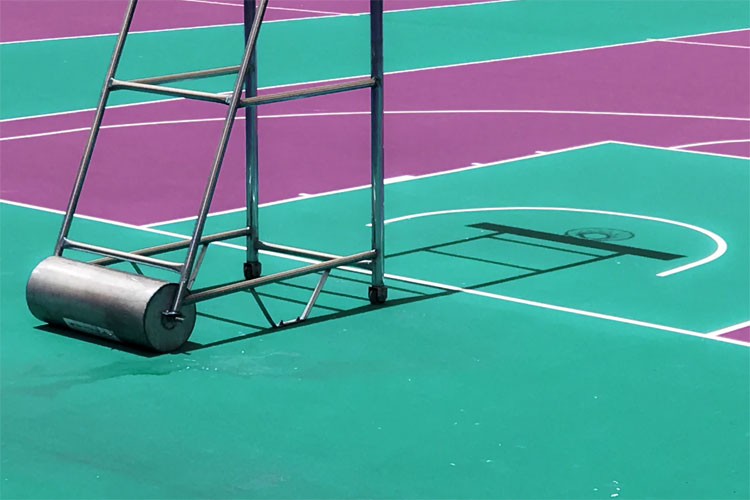
Heavier and less portable systems have bigger bases that accommodate more weight. Those on the pricier end of the spectrum can easily hold over 50 gallons of sand or water.
No matter your budget, what you want in a base is stability. If your area experiences strong gales and frequent snowstorms, opt for sturdier hoops that can endure inclement weather.
You may also consider a hoop with a wheeled base so you can easily move it for safekeeping.
Expert Tip: If you decide to fill the base with water, add a bit of base gel. Doing so will prevent it from freezing up in the winter and promote greater stability. It also minimizes leakage.
Support Pole
Another vital component of any good hoop is a quality support pole. It supports extra weight and adds height to your basketball hoop. Most portable systems allow you to adjust the height of the hoop between 6 and 10 feet.
Excluding the Spalding NBA 54 Angled Pole Backboard Portable Basketball System, our selections above use retractable poles. Simply twist the knobs (like you would with a telescope) to achieve your desired height.
Expert Tip: Multiple-piece support adjustable height poles are generally flimsier than their single or two-piece counterparts. If you’re looking to lessen your basketball hoop's wobble and perform more dunks, it's best to choose poles with higher density (e.g., solid steel) and lesser segments.
Backboard
The quality of your ball game rests upon your backboard. The backboard material will influence how well your bank shots, lay-ups, and rebounds go through the basket. They also impact the backboard's capacity to endure powerful dunks.
However, remember that these techniques still rely on your skill as a player.
Portable basketball hoops generally feature a smaller backboard size than the standard tempered glass backboard used for official tournaments. You may encounter regulation-size home basketball systems in the market, but these are often in-ground installations.

If you value performance, don't be afraid to splurge on a quality backboard. Manufacturers offer many varieties. You can choose from an acrylic or polycarbonate backboard, a hybrid, or even tempered glass.
These products can withstand harsh elements and minimize the adverse effects of natural wear and tear.
Expert Tip: It is prudent to read others’ reviews when evaluating backboards before buying a hoop. Users who own low-grade basketball hoops with poorly-made backboards often have to repair them or completely replace their playsets.
Make the wiser investment by choosing a portable basketball hoop that gives the most bang for your buck.
Rim
Don't underestimate the effect the rim has on a basketball session. Rims may share a uniform size across all basketball hoops, but they differ widely in performance. You have two options: a bolted rim or a breakaway rim.
A bolted rim attaches to a backboard through screws and braces, meaning any force exerted on the basket will directly impact your backboard. When this happens, your backboard could suffer tremendous damage. You’re also at higher risk of wrist injuries if you attempt to dunk on a bolted rim.
On the other hand, a breakaway rim can endure more pressure than a conventional rim. They bend at a certain angle to lessen the bounce produced by powerful shots. This reduces delays in rebound shots and the time you spend chasing errant balls.
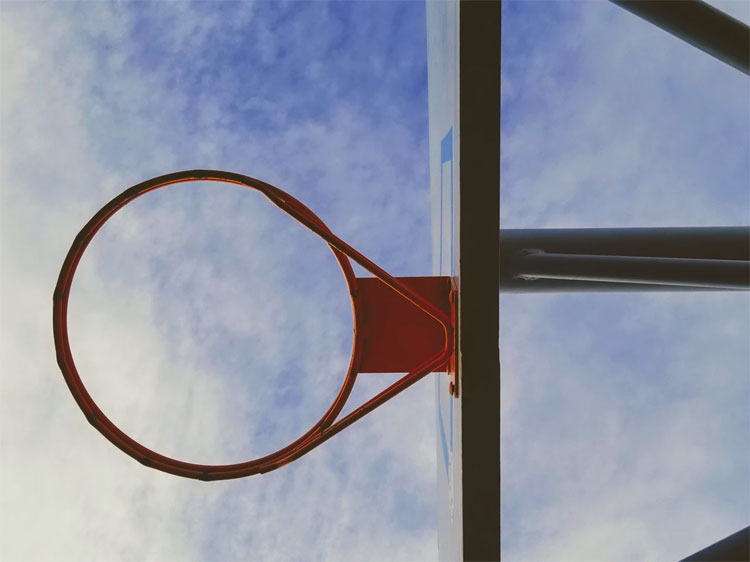
Players who want to enjoy longer and more aggressive basketball sessions prefer a breakaway rim because it allows continuous gameplay. Breakaway baskets are also a safer option for those who want to keep their wrists intact.
Expert Tip: Deciding between a bolted and breakaway rim entails a cost-benefit analysis. Bolted rims are often cheap and weather-resistant, but they don't facilitate dynamic plays. Conversely, compression rings in breakaway rims make them much pricier, but some of them are prone to rust.
If you've set your sights on a hoop with a breakaway rim, choose one with rustproof compression rings.
Net
The net is just as important as the rim. If you’ve ever played on a hoop with a net-less basket, you know how frustrating it is to run after wayward balls. It may even demotivate you to make successful shots.
When choosing a basketball hoop, make sure it comes with a net or factor the cost of one into your purchase.
Portable basketball hoops typically use netting made of nylon fiber - a thermoplastic designed to tolerate extreme temperatures and severe weather. Its silky texture also prevents the basket from getting entangled, so don’t worry about your ball never making it to the ground.
Expert Tip: Avoid hoops with metal chains because it can wear down the leather in your precious Spalding. Polyester is also a viable choice, but it won’t fare well against the elements. When it comes to the best basketball nets for outdoors, nylon takes the top spot.
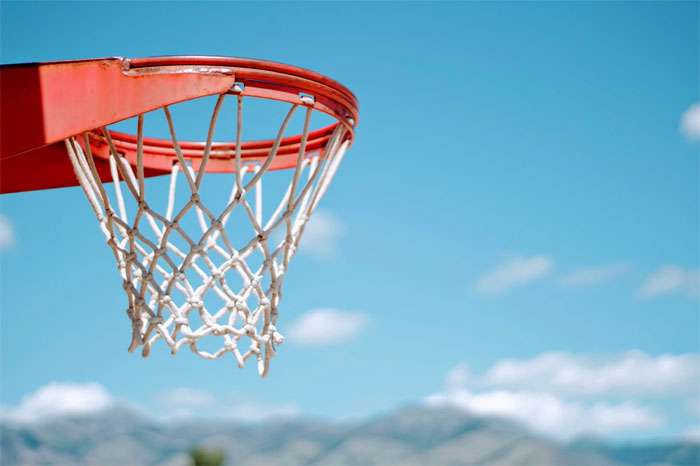
3. Follow Assembly Instructions to the Letter
Portable hoops come with instructions and the necessary nuts and bolts to put them together. It pays to read the manual thoroughly to avoid mishaps during assembly.
You can work more efficiently by calling a friend or two to assist you.
4. Give It a Play Test
Your portable basketball hoop may look great on paper, but how does it hold up to actual gameplay?
If you’re not the kind to fuss over details, an alternative way to evaluate your basketball system is to just play on it.
Does it wobble at the slightest push? Do you notice frays in the net or scratches in the backboard? Take advantage of the service warranty. If it doesn’t work as advertised, call a sales rep for a refund.
FAQ: Ready to Buy a Portable Hoop?
Finding the best portable basketball hoop doesn't stop there. Before purchasing your basketball hoop, you may have more questions in mind:
Are there additional costs to portable basketball hoops? How will you maintain it? Should you ask professional help? How can you tell if one hoop is better than the other?
Let's look at the answers to these questions as well as maintenance requirements, installation techniques, and other nifty tips and tricks to maximize your basketball system.
We'll get down to the nitty-gritty of portable basketball hoops.
Which is better: a portable or an in-ground hoop?
That depends on your play style, budget, available space, and other preferences.
Play Style
If you’re determined to simulate pro court gameplay, consider an in-ground hoop. The standard components of a mid-range model include a:
These features are exclusive to higher-end portable hoops. If you merely want to host casual ball games, mobile basketball systems are more accessible. Their adjustable height also makes them more versatile—suitable for kids, teens, and adults.
Budget
Generally, top-tier portable basketball systems can compete with the average in-ground installations. If money were no object, you might even own a portable system that performs better than a low-end in-ground fixture.
All components considered, both the in-ground and portable hoop markets offer many great options for folks on a tight budget.
Available Space
Since in-ground playsets are immovable, they typically require a dedicated space in your yard.
Regular maintenance is also mandatory for these permanent fixtures. That's not to say that portable hoops need no upkeep at all. They still demand your care and attention, albeit at lesser intervals.
Which is best: an adjustable height hoop or a fixed pole?
The primary benefit of an adjustable height pole is to cater to younger players.
The standard height adjustment for portable basketball hoops is 7.5 feet to 10 feet, so you can lower the post when playing with children and raise it back up to regulation for standard games.
Most manufacturers borrow the height adjustment mechanism used in telescopes when designing retractable poles. Low to mid-range hoops limit you to height adjustment in 6-inch increments, while higher-end hoops give you the absolute freedom to lengthen or shorten your pole however you like.
Conversely, a fixed pole discriminates against child players as it doesn't allow you to adjust the height.
However, what a fixed pole lacks in flexibility, it makes up for in strength. Rigid posts are less prone to bending and snapping.
How do you hold down a portable basketball hoop?
The best way to stabilize a portable basketball hoop is by filling its base with sand or water. Adding weight is straightforward.
For water, attach one end of a hose to a water source. Take the other end, and place it on the opening of the base. For sand, funnel the grains into the base’s hole.
Each option has a unique set of pros and cons.
Water
Water bases are easier to fill and empty, but they’re also more susceptible to leakage. In locations that experience harsh winters, the water tends to expand as it freezes, causing the base to shatter. You can avoid this by adding an antifreeze solution to the base, emptying it, or moving the entire unit indoors.
Ambient heat is another problem for water bases. At high temperatures, water evaporates. As the vapor escapes, the base becomes less stable, so make sure to inspect your base’s water levels regularly.
A pro tip is to mix base gel, an absorbent polymer, into the water to prevent mold and algae growth. Once the water mixture thickens, it'll fill in the nooks and crannies where water or vapor may leak.
Sand
Packing the base with sand takes more time and effort, but it adds better stability and makes for a truly sturdy base.
Since sand is much denser than water, it neither evaporates nor freezes (unless it’s moist). Keep in mind, though, that sand weighs more per gallon, so your base will become more challenging to move.
While sand or water is a great choice, avoid placing heavy objects like rocks, sacks of soil, or spare tires on top of your base. Doing so will subject your hoop to undue pressure and cause the base to crack. Reinforce your base correctly to prolong your basketball system’s lifespan.
Can I convert a portable basketball goal to in-ground?
Yes, with enough diligence, you can.
Converting a portable basketball hoop into an in-ground installation will likely take a day or two to finish. You’ll also need special tools such as a hacksaw, a screwdriver, a shovel, a ladder, buckets, a wheelbarrow, and even a jackhammer.
The first step is to dismantle your portable basketball hoop. Lay it on the ground face-up. Using your screwdriver, detach the basket from the backboard, and unhinge the backboard from the frame. Set these parts aside as you move to the support pole.
If your base attaches directly to the pole, you'll need to cut it with a saw. If not, unscrew the pole from the base. Once you’ve completely disassembled your basketball system, you may employ the following methods:
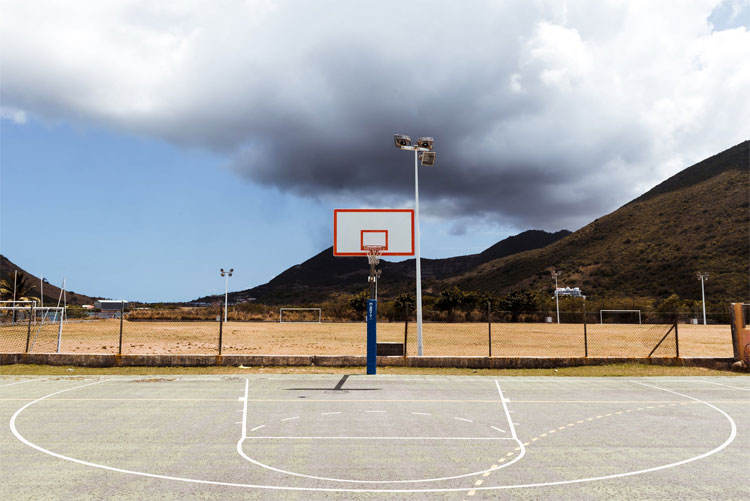
Ground Sleeve
If you want to retain your basketball hoop’s portability, a sleeve installation is a perfect solution.
The meticulous process involves digging a four-foot deep hole on the ground and inserting a metal tube into the hole. The tube (i.e., the ground sleeve) must be wide enough to accommodate the support pole, but not too wide that the pole wiggles. You must then fasten the pole into the ground sleeve.
Direct Burial
Direct burial is a traditional method to install in-ground hoops. Dig a four-foot hole on the ground as you would in the ground sleeve method and stick the pole into the hole. To keep the hoop upright, fill the gap with quick-dry cement.
Be sure that your pole stands perpendicular to the ground as you can no longer adjust it once the cement sets. We recommend waiting for the cement to dry before reinstalling other components.
Anchor System
The third option is to fasten the pole to the ground. You can achieve this by attaching the pole to a metal sheet and anchoring that plate onto a flat, paved surface using J-shaped bolts.
The anchor system’s primary advantage is that you could easily unbolt the pole should you need to relocate.
Whatever technique you choose, be sure that the support pole stands at a right angle. Once you’ve accomplished this, you may proceed to reattach the backboard and rim.
What’s the best portable basketball hoop to buy?
As we’ve discussed in the previous section, choosing the best portable basketball hoop entails thoughtful consideration. No one-size-fits-all answer exists to address this question.
You must narrow down a single choice, inspect its components, assemble it properly, and put it to the test.
Along with these steps, you should also be mindful of your budget, play style, and available space. Every other factor will boil down to your preferences.
Which portable basketball hoop is best in a driveway?
The best basketball hoop for use in a driveway depends mainly on your location, purpose, and time commitment. Do you merely want to play for fun? A low to mid-range basketball system will suffice.
Is your area frequently subject to severe weather? If so, opt for a more durable build with a high-density steel pole, a sturdy base, and a tempered glass, acrylic, or polycarbonate backboard. They may be heftier purchases upfront, but they fare better in the long run.
You also need to consider maintenance as some portable basketball hoops demand a little more upkeep than others. Refer to our buyer’s guide above to explore more of these concepts in greater detail.
What should I look for when buying a portable basketball hoop?
No hoop could be deemed the best portable basketball system without the perfect build. When deciding among several mobile systems, it's essential to examine each component.
Is the base easy to move? Does the backboard accommodate high-intensity action? Can you dunk on it? Even the tiniest detail can significantly impact a hoop's performance.
What are the hidden costs of portable basketball hoops?
Mobile basketball systems may be sound investments, but they are not without issues. Many things could go wrong when setting them up, leaving a massive dent on your wallet.
Let’s take a look at common problems portable hoop owners face:
Unstable Base
The bases of portable hoops on the cheaper end of the spectrum are typically prone to damage. The base may crack if someone steps on it. Direct sunlight can also wear down cheap plastic and deform it.
In the colder months, water can freeze up or add uneven weight to the base, causing your hoop to tip over. Since most users install their basketball systems in their driveways, this presents several hazards.
If the hoop lands on your car, it could shatter your windshield, leave scratches on the metal, and ruin your car’s appearance. It could also harm unsuspecting players.
Expert Tip: Use denser weight, such as sand or base gel, to promote better stability and reduce leakage.
Brittle Backboards
Not all backboards can weather the elements. Thin acrylic can only resist limited wind speeds, and strong gales often carry debris that may chip away at your backboard’s surface.
Prolonged exposure to UV rays also makes your backboard brittle, especially if you have a polyethylene or polycarbonate backboard.
Suppose you attempt a half-court bank shot on a frail backboard. This can cause it to shatter. Even worse, the shards will deflate your ball and may impale other players.
Expert Tip: If you own a lower quality basketball system, treat it gently and devote more time for maintenance. Avoid dunking on it or exerting more force than it can handle.
You can also lengthen its life by storing it in a secured area like your garage or tool shed.
Bent Steel Pole and Rim
The screws on a three-piece steel pole tend to loosen over time, causing it to bend. The same case also applies to bolted rims. Will you still enjoy shooting through a vertical basket? We don’t think so.
Given the increasingly competitive market, most manufacturers discontinue older hoops in favor of newer, more durable units.
This cycle leaves users with fewer replacement parts. When your portable hoop eventually succumbs to gravity, you may have to replace it entirely.
Expert Tip: If you want your portable hoop to last more years, make it a habit to inspect the steel pole and rim regularly. Tighten screws as necessary and fortify them using UV and rust-resistant powder.
If this is not possible, consider owning an in-ground hoop instead.
Should I install portable basketball hoops myself, or do I need to call professionals?
Most mobile basketball systems have easily understandable instructional manuals that anyone can follow. However, teens and kids may need help. Read your service warranty to see if it covers free installation.
In-ground fixtures typically require more supervision and specialized equipment. You will need to mark underground pipes and power lines before installing them.
Whether you employ the ground sleeve, direct burial, or anchor method, it’s best to contact professionals for assistance.
Related: How to Install a Basketball Hoop for Your Home (with Pre-Purchase Guide)
What is an overhang?
The overhang on a portable basketball hoop is an often-overlooked component. It refers to the distance between the support pole and the front of the backboard.
A longer overhang adds greater stability to your basketball hoop and facilitates better gameplay. However, it reduces your play area.
The standard overhang length in professional courts is 5 feet. Mobile basketball systems typically feature a two- to four-foot overhang. If you have limited space in your backyard or driveway, opt for a portable hoop with a shorter overhang.
Are portable basketball hoops safe?
If you follow the precautions that come with your basketball hoop, yes, they typically are. Most manufacturers forewarn users whether you can dunk on the unit. Be wary of swinging from bolted rings as doing so could break your wrist.
It’s also essential to read the assembly instructions carefully. Your hoop could topple if you fail to fill your base with the correct amount of weight or leave out a screw. If you aren’t mechanically-inclined, reach out for help. It will save you significant time.
Ensure that you’re working with a legitimate retailer. Hoops marketed as “factory-direct” products deserve closer inspection.
Consult user reviews on the web if you’re doubtful of a particular business’ offering so that you won’t regret your purchase.
Takeaway
The portable basketball hoop industry has a long way to go before it can deliver the same experience playing on a professional court offers. It also needs stricter regulations to combat counterfeit retailers.
Despite the circumstances, residential basketball is taking off as a popular standalone sport.
Analysts report a considerable growth and greater competition in the mobile basketball system market, so expect newer and more exciting features in the years to come - but for now - the five options listed here are hands-down the best portable basketball hoops available. The top pick is in your hands.











